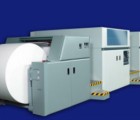Sydney’s SOS Print & Media Group has become the first Australian customer, and in the first ten days of its installation had already racked up an impressive three million pages, a throughput Oce Australia believed had not be bettered anywhere in the world. Oce says a further five Aussie printers have already signed up for the VarioPrint.
At the core of the VarioPrint 6250 is a completely new print engine, designed for the double sided production. Named Gemini after the Latin for twins, and with a nod to a conventional blanket to blanket perfecting press, the new engine creates the image, fuses and transfers the toner simultaneously onto two blankets directly opposite each other, then as the sheet passes though the blankets transfer the images to each side of the paper at the same time. This makes for both an easy paper path, and more crucially totally accurate registration. Oce says some 80 per cent of high volume monochrome work is double sided, and with Gemini requiring just one pass it believes the VarioPrint 6250 should have high appeal.
Steve Wilson, managing director of Oce in Australia says, “Oce’s philosophy is to be technology driven, and so its spending on R+D is increasing, with the fruit of that spend shown in innovative products such as the VarioPrint 6250. Australian printers will derive very substantial benefits with the new technology of the VarioPrint 6250.”
Océ says the VarioPrint 6250 is suitable for production volumes of between 600,000 and eight million prints per month. The new digital printer produces 250 duplex A4 or 132 duplex A3 prints per minute. Oce claims that on average the Océ VarioPrint 6250 is 70 per cent faster than all other high volume printers.
The Océ VarioPrint 6250 will be aimed at both commercial printshops and the in-house corporate print room, where higher speed duplex printing will mean more efficient production of manuals and technical documentation. Océ says the VarioPrint 6250 also offers new business opportunities to graphic arts printers in the production of the short-run digital books. The VarioPrint 6250 works with various finishing solutions.
SOS Print is one of the country’s early pioneers in digital printing, it has been running a combined offset and digital operation for the past eight years, and works with partner companies in all Australian capitals and New York, London, Hong Kong and Japan to offer a distribute and print model to the financial markets. With a turnover of some $25m, and a further $7m coming from its Brisbane partner CPX, SOS is one of the country’s largest independent print shops.
SOS director Michael Shulz says, “The VarioPrint 62350 appealed to us because of its speed and quality combination. The speed is rivalling offset, and so is the quality. The front to back registration and the low heat are both technologies that are particularly beneficial in overprinting.”
Output quality is 600x1200dpi, and it accommodates cut sheet stocks ranges of between 60-200gsm. Tim Saleeba, marketing manager at Oce says, “The VarioPrint 6250’s ability to print on a wider sheet range means that users will be able to offer their customers a broader job range, and they will be able to capitalise on that benefit.”
Océ says the VarioPrint 6250 printer has the largest paper input/output capacity for larger media sizes such as A3, ledger and RA3. It supports A4, letter, A3, ledger, oversized and custom size media, as well as tabs and inserts from any of its 12 trays. No additional interposer is needed. Users can load up to 13,800 sheets of any size at once to promote unattended printing for up to four hours. With ‘load paper while you print’ functionality, the system can print up to 16,000 prints per hour with minimal operator intervention. An optional output module of 12,000 sheets also supports this increased throughput.
The Océ VarioPrint 6250 also features numerous other technological innovations. Advanced Active Registration technology uses intelligent sensors and direct drive motors to ensure perfect sheet positioning and print registration. The single-pass technology supports perfect registration for books, manuals and other publications, since the system prints both sides simultaneously. To ensure correct printing on pre-printed and pre-punched stocks, Océ employs a new technique called Paper Logic which it says takes the guesswork out of paper orientation. The resulting system performance will enable printing professionals to move jobs from offset to on-demand digital printing.
Comment below to have your say on this story.
If you have a news story or tip-off, get in touch at editorial@sprinter.com.au.
Sign up to the Sprinter newsletter

